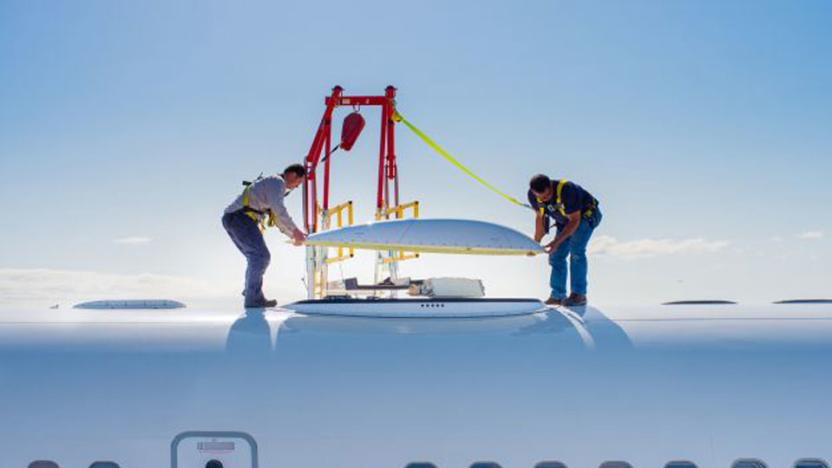ka-band
Latest

Amazon's custom Ka-band antenna will deliver less expensive satellite internet
Amazon unveiled on Wednesday a revolutionary Ka-band phased array antenna design that will allow for more compact and less expensive user terminals.

Amazon asks FCC for permission to launch internet satellites
Amazon is moving fairly quickly on its plan to deploy thousands of internet satellites. The company has filed for FCC permission to launch 3,236 satellites as part of Project Kuiper. The spacecraft would be grouped into 98 orbital planes, and fly at altitudes between 366 and 391 miles. The filing reiterated Amazon's plans to connect "tens of millions" of people around the world, although the company warned that it couldn't cover everything -- it asked for a waiver on a requirement to serve the whole US as its satellites wouldn't cover parts of Alaska.

American Airlines offers satellite WiFi to its entire mainline fleet
If you're relying on American Airlines for a summer trip, there's a good chance you'll have internet access most of the way. The company has finished deploying satellite-based internet access to the fleet of 700-plus narrowbody aircraft that mainly handle its domestic routes. Depending on where you're going, you'll have either Gogo 2Ku or ViaSat Ka connections providing speedier, more consistent WiFi than the ground solutions of old. American deployed satellite broadband to its widebody aircraft roughly a year earlier.

Spirit is first budget airline in the US to offer WiFi
As a rule, traveling with a budget airline in the US means foregoing any kind of mid-flight WiFi access. Not so with Spirit, though. The no-frills air carrier is rolling out internet access to its aircraft this fall, with the entire fleet expected to have connectivity by summer 2019. It might even be usable, unlike some options -- Spirit is relying on Ka-band satellite access, and is promising another speed upgrade when the SES-17 satellite reaches orbit in 2021.

Quika promises free satellite internet for developing countries
Facebook's plans for free satellite internet access may have run into some... setbacks, but another company is promising to make that ubiquitous data a practical reality. Quika, a company led by the chief of satellite provider Talia, is launching a free satellite broadband service in the second quarter of 2018. It's promising speedy, low-latency Ka-band data in developing countries where income inequality and a lack of infrastructure (especially in rural areas) make conventional internet access impractical for most. Service will begin with Afghanistan, Iraq and most of Africa, but there are promises of more countries afterward.

JetBlue will have free satellite WiFi on every flight by fall 2016
JetBlue's plans to outfit its aircraft with fast satellite WiFi are most definitely on track. The airline has announced that it not only has Fly-Fi on all of its Airbus aircraft, but that it expects to have the free internet access aboard all its remaining flights by fall 2016. That's a big deal, particularly if you're a frequent flier -- it guarantees at least one carrier that will have relatively brisk (20Mbps per device) connections on every trip, whether it's a short hop or cross-country. JetBlue no doubt hopes that you'll use its expanding service to buy a few things, but it's hard to be too cynical about the company's motives when some other airlines charge you for WiFi that's virtually unusable.

Virgin's new in-flight WiFi is strong enough to stream video
Virgin America has announced that it's teaming up with satellite internet company ViaSat to provide the fastest in-flight WiFi of any commercial carrier. The new system uses a hybrid Ku-/Ka-band receiver to deliver an internet pipeline eight to 10 times faster than anything else on the market. The Ka-band alone offers a whopping 140 gigabits-per-second throughput. It's being installed on the company's new fleet of A320 airliners and will be put into service on Hawaii-bound routes starting next year. That alone is a big accomplishment as the rest of the airline's fleet have to rely on ground-based WiFi connections, which don't work over the ocean's expanse. Virgin touts that this in-flight connection will be equivalent to an average home broadband link and users are expected to use it as such, streaming videos, watching the carrier's 18 channels of DishNetwork and surfing the internet with abandon -- just at 35,000 feet.

Honeywell gets YouTube videos to play over global in-flight WiFi
The days of staying offline during your international flights might be coming to an end. Honeywell and Inmarsat have successfully stress-tested their global Ka-band satellite internet access in mid-air, doing everything from streaming YouTube videos to holding conference calls. The dry run shows that space-based broadband should be viable around the world, not just in certain areas -- fly to Europe and your mid-trip WiFi connection should vaguely resemble what you have back home. It'll take a while before airlines get the Honeywell/Inmarsat hardware into their fleets, but one of the biggest challenges is over.

Delta's in-flight WiFi is about to get a whole lot faster
If you've flown Delta recently (or most domestic airlines) and tried to use the onboard Gogo WiFi, you know that it's often a crapshoot. A combination of where you're flying over and the number of passengers attempting to use it leads to either a decent connection (yay!), one that's slow as a snail (ugh), or none at all ($#!%). Look, we need to remember that sending tweets at 35,000 feet is basically magic. But being able to stream even a low-res YouTube clip would really make flying a happier experience.

El Al teams up with ViaSat for speedy in-flight WiFi on flights to Europe
ViaSat's not yet a household name here in the US, but the company's super-fast WiFi is well on its way, due in no small part to successful launches on JetBlue and United. Now, the satellite provider is set to bring its Exede in-flight internet to El Al passengers, operating on several 737s between Tel Aviv and cities in Europe. Unlike the North American service, which connects to ViaSat-1, this European counterpart will hook up with Eutelsat's Ka-Sat, with ViaSat's terminals and antennas handling the connection on each plane. El Al plans to launch the Ka-band service within the next year.

JetBlue Ka-band high-speed internet now arriving in early 2013, eight times faster than the competition
JetBlue Airways' high-speed wireless initiative is being held in a flight pattern until "early 2013," apparently. The company announced as much in a detailed blog post this afternoon, which also compared speeds of its forthcoming in-plane high-speed internet to the competition -- JetBlue's Ka-band operates roughly eight times faster than the Ku-band competition, and over nine times faster than ATG. Moreover, Ka-band can scale to a full plane of passengers, meaning everyone gets the "at-home experience" they'd like regardless of how many folks are signed on. As previously noted, the "basic Wi-Fi" service with JetBlue will cost nothing -- which sounds to us like there are plans to reveal a more expensive tier (or tiers) in the near future. But then again, we really like free things.

Intellectual Ventures launches Kymeta spinoff, promises slim satellite broadband hotspots
Intellectual Ventures is best known for its tendency to sue everyone, but it's going some distance to mend that bruised image through a newly spun out company, Kymeta. The startup hopes to improve the quality of satellite broadband through mTenna-branded, Ka-band hotspots made from metamaterials -- substances that can boost and manipulate a satellite signal while occupying virtually no space, leading to self-pointing transceivers that are just a fraction of the size of what we use today. That still amounts to equipment the size of a laptop running at a peak 5Mbps, although it's small enough that Kymeta sees hotspots reaching individual customers who want access from a boat, a car or the field. We'd just advise against tossing out the MiFi too quickly. Kymeta doesn't expect the hotspot to be ready before late 2014 at the earliest, and that leaves many questions about how much of a hit we'll take to the pocketbook.

Avanti launches prepaid, Ka-band satellite internet access, wants us Yelping from the Alps
Avanti has been beaming satellite broadband to Europe for awhile, but it's been tied to a subscription through carrier deals. That's a tough sell to customers who, by definition, don't want to be tied to anything -- which is why the company just launched prepaid satellite internet access for the continent. Although the Ka-band service's 4Mbps downstream and 1Mbps upstream speeds won't have anyone dropping their 330Mbps fiber anytime soon, the pay-as-you-go strategy will let travelers and rural dwellers get broadband in a pinch, no matter how spotty terrestrial access might get. Imagine Skype calls during Swiss ski vacations and you've got the gist of it. Carriers will resell the data in healthy doses of 1GB or larger, and Avanti is adamant that there won't be any nasty throttling surprises waiting in store. While exact prices will depend on partners, the provider isn't waiting for those details before it covers much of the Old World: its upcoming HYLAS 2 satellite (what you see above) will share the speed with Africa, the Caucasus region and the Middle East as of August 2nd, making it almost too easy for us to update Google+ in Georgia.

Delta expanding Gogo in-flight WiFi to select international flights beginning in 2013
Delta Airlines isn't a stranger to offering WiFi on many of its domestic US flights, but using Gogo's air-to-ground connection setup has essentially kept it from taking off over the seas. That's all set to change come 2013, however, as 150 of Delta's long-haul aircraft will make use of all those high-bandwidth Ku-band capacity satellites that Gogo has been acquiring over the past few months. The updated setup will ensure that you can update your Facebook status over the likes of the Atlantic, but it won't be fully rolled out until about 2015. By that time, the airline estimates it'll be operating around 1,000 Gogo-equipped aircraft worldwide -- not too shabby. If anything, the wait to hit 10,000 feet is surely going be more interesting for all the international work-a-holics out there. Hit up the press release after the break for more details in the meantime.

Gogo spreads its in-flight WiFi wings further with SES satellite deal
Rejoice frequent-flying lovers of the Interwebs. All systems continue to be a go for in-flight WiFi provider Gogo as the company inks a deal with yet another satellite operator. A new agreement with global satellite company SES puts Gogo closer to providing seamless WiFi for passengers on intercontinental flights that use its service -- SES' coverage area includes the United States, Europe and the Atlantic Ocean region. The agreement comes along the heels of deals signed by Gogo with Inmarsat for Ka-band frequency service and AeroSat to use its HR6400 satellite communication system for Ku-band connections. The company says Ku-band service could be available on commercial flights using Gogo's network as early as the end of this year, providing more options for, say, Airtime video chat hijinks. As long as Internet access prevents bored kids from kicking the back of our airline seats, then it's all good.

Gogo and AeroSat get friendly on Ku-band, bring international in-flight WiFi closer
Gogo has a virtual lock on in-flight WiFi for the US, but most of us forget that everything goes dark the moment you decide to cross the border. The company already has a deal with Inmarsat for Ka-band Internet connections, and now it's partnering up with AeroSat to bring Ku-band satellite access. The tie-in will let Gogo offer precious relief from tedium on international flights, whether it's a modest hop to the Great White North or an hours-long trip across the ocean. Gogo considers the deal an interim step until Inmarsat's technology is ready, making for much quicker availability than if it had just waited until it could use Ka-band: Ku-band satellite linkups should be on airliners as soon as the end of 2012, while Ka-band won't even show its face until at least late 2014. It's unknown what kind of premium we'll pay over the $13 maximum Gogo normally charges, but if AeroSat lets us squeak in a few more Twitter updates on our way home from Barcelona, it'll be worthwhile.

Satellite web surfing at 40Mbps with ViaSat SurfBeam 2 Pro (video)
If you've been relying on a satellite modem for your daily dose of the Internet, you're probably all too familiar with sub-1Mbps download speeds and an overall painful experience. That's exactly why we've been so impressed with ViaSat and its new 12Mbps down, 3Mbps up Exede residential satellite broadband product. Yesterday, we journeyed deep into Camp Pendleton near San Diego to test out those 12/3Mbps speeds on the go-anywhere SurfBeam 2 Pro Portable, and now we're back to play around with the enterprise setup's more stationary sibling, the SurfBeam 2 Pro. The modem functions in much the same way as ViaSat's less-expensive household version, though there's a bit more horsepower under the hood.The sample we saw at the company's Carlsbad, CA headquarters is also provisioned for faster service, delivering throughput in excess of 40Mbps down, letting you transfer files from the web at speeds you'd typically only be able to meet with a fiber connection. That may be a bit excessive for regular web use, but if you need to download software, movies or other large files in remote areas, that extra speed will likely be more than welcome. Join us past the break for a quick look a Exede, followed by a demo of the enterprise version and its 40Mbps downloads.

Live from Camp Pendleton with ViaSat SurfBeam 2 Pro Portable (video)
There's no power outlet, land-based internet connection or even a decent cell signal in sight, yet we're posting this live, at fast broadband speeds. We're miles deep into Camp Pendleton, connected to ViaSat's SurfBeam 2 Pro Portable mobile satellite transceiver and sending data to and from ViaSat-1 located more than 20,000 miles above our heads. SurfBeam 2 wasn't designed for us to kick back and surf the web in the middle of nowhere at speeds that we could barely achieve while tethered to a cable connection just a few years ago, but we're doing just that, with ViaSat's roughly $20,000 go-anywhere satellite broadband rig. We first heard about Pro Portable last month at CES, which the company is marketing towards military, emergency management personnel and even broadcasters -- that's right, the sat truck of the future fits inside a hand-carry suitcase, and sends HD video from the world's most remote locations right back to broadcast centers at record speed, nearly eliminating that lag that makes certain CNN reports painful to watch.Pro Portable really can go anywhere -- disassembled, it fits inside a fairly modest suitcase, but screw it together and you have a full-size dish. There's also a four-port Ethernet router and an optional battery pack, which provides up to four hours of juice. Think of it as Exede broadband for far-off-the-grid types. Sadly, Pro Portable isn't priced low enough to make its way into your on-the-go blogger kit, but it costs a small fraction of the million dollars you can spend on a sat truck, which rents for thousands of dollars a day. It's also far more transportable and discrete, offering consistent 12 Mbps download and 3 Mbps upload speeds nearly anywhere in North America. How can SurfBeam 2 hold up during a bandwidth-intensive HD upload? See for yourself just past the break -- our 230MB hands-on video made its way from the ground to space and back to Viddler in just shy of 13 minutes, and our Skype video call looked fantastic, without any noticeable lag.

ViaSat residential satellite broadband internet hands-on (video)
Last Thursday, ViaSat announced pricing for its new home broadband service, which is set to deliver 12 Mbps+ download speeds (3 Mbps+ up) beginning next week for $50 per month. We just dropped by the company's demo home just a few feet from the Engadget trailer at the Las Vegas Convention Center parking lot to try it out, and were quite impressed with the speeds we saw, especially considering that data was passing through the ViaSat-1 satellite thousands of miles above the Earth. We've used other satellite internet services before, and while there's still just over a half-second of latency, bandwidth speeds were significantly faster than what we've experienced with other services in the past. HD YouTube videos loaded very quickly, after a brief delay, as did Engadget and many other media-rich news websites. We performed a speed test and registered ping speeds of about 600ms, download speeds of about 30 Mbps and upload speeds of about 2 Mbps, but results aren't as accurate as they would be with a land-based connection because of latency and the way packet data is handled. We also placed a VOIP call, and while the delay was noticeable there, it was still usable. Want to see for yourself? Jump past the break as we step through ViaSat's front door to hop online.

ViaSat details home broadband, 12 Mbps service to roll out on the 16th for $50 per month
Earlier this year, ViaSat launched its ViaSat-1, a 140 Gbps capacity satellite positioned over North America. We've already heard about plans to bring Ka-band coverage to the friendly JetBlue skies later this year, but now the new broadband provider has detailed residential availability as well, through the National Rural Telecommunications Cooperative. NRTC members will have access to 12 Mbps service packages starting at $50 per month as soon as January 16th, finally bringing high-speed broadband to areas where fiber and cable services are not available. ViaSat may not be rolling out to consumers for another couple weeks, but the provider will be on-site at CES to demo the service in "residential, commercial airline, and satellite newsgathering" scenarios beginning Tuesday, and you better believe we'll be there to test it out.






